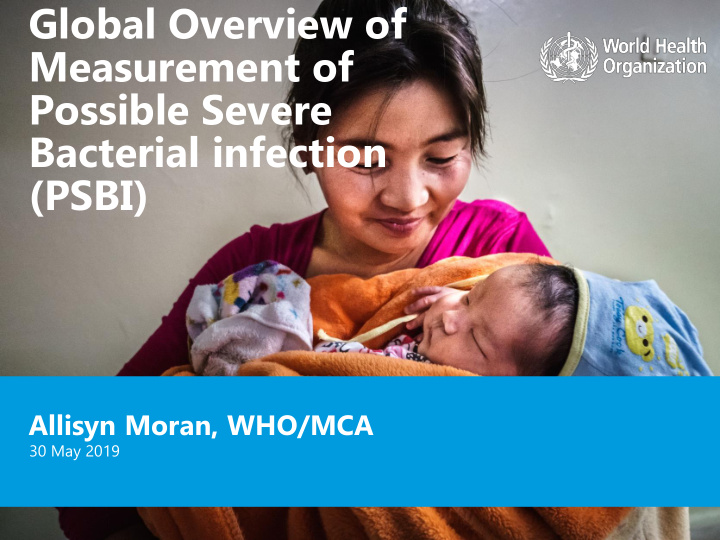



Global Overview of Measurement of Possible Severe Bacterial infection (PSBI) Allisyn Moran, WHO/MCA 30 May 2019
Outline of Presentation • Burden of neonatal sepsis Suggested indicators for PSBI monitoring • • Challenges and next steps 5/29/2019 2
Global causes of under-five death, 2017 Leading causes of postneonatal deaths are acute respiratory infections, diarrhoea, other infections, injuries and malaria Neonatal (47%) Postneonatal Leading causes of neonatal deaths are prematurity, birth asphyxia, sepsis and congenital anomalies
Every Newborn measurement improvement roadmap 2030 5 year plan with >80 partners Led by WHO with LSHTM End Preventabl e Maternal and Newborn Deaths including Stillbirths ENAP Milestones regarding measurement • Count births and deaths in CVRS and surveys (women, newborns and stillbirths) 2020 • Every newborn core indicators to be defined , incorporated in national metrics platforms and used • Perinatal mortality audit and minimum dataset being widely used Effective use of data in national 5 INDEPTH sites (65,000 births) with randomised comparison of survey INDEPTH STUDY health modules to improve survey methods to capture SBR, NMR, birthweight, GA informatio n systems Facility births (20,000) in Bangladesh, Nepal, Tanzania validating indicators for EN-BIRTH STUDY rhesus, KMC, neonatal infection treatment, ACS, uterotonic use Follow up EN-BIRTH newborns in Bangladesh, Nepal, Tanzania to test simpler EN-SMILING STUDY child development metrics, assess ECD outcomes after basic neonatal care SMALL & SICK Define content, competencies for care of small and sick newborns, compare data platforms, develop std HFA content, barriers/enablers to data collection NEWBORNS
Every Newborn Action Plan Indicators Current Status Core Indicators Additional indicators 1. Maternal mortality ratio 2. Stillbirth rate Intrapartum stillbirth rate Definitions clear Low birth weight rate 3. Neonatal mortality rate but quantity & IMPACT Preterm birth rate consistency of data Small for gestational age lacking Neonatal morbidity rates Disability after neonatal conditions 4. Skilled attendant at birth Antenatal Care Contact point 5. Early postnatal care for mothers & babies Exclusive breastfeeding to 6 months definitions clear COVERAGE 6. Essential newborn care (tracer, early but data on Care for all mothers breastfeeding) content of care are and newborns lacking 7. Neonatal resuscitation Caesarean section rate COVERAGE 8. Kangaroo mother care Gaps in definitions, Complications and 9. Treatment of serious neonatal infections Chlorhexidine cord cleansing requiring extra care 10. Antenatal corticosteroid use validation and feasibility testing Emergency Obstetric Care INPUT for HMIS use Care of Small and Sick Newborns Service readiness for Quality of Care Quality of care with measurable norms and standards Birth Registration Death registration, cause of death COUNTING Shaded = Not currently routinely tracked at global level Bold red = Indicator requiring additional testing to inform consistent measurement Adapted from Every Newborn Action Plan. WHO, 2014. www.everynewborn.org and Mason et al Lancet 2014
Coverage indicators 5/29/2019 6
ENAP - Treatment of Severe Neonatal infection Process indicator: Numerator : Number of facilities in which gentamicin is available at suitable peripheral level for treatment of severe neonatal infection Denominator : Number of facilities assessed Data source : Health facility assessment Coverage indicator: Numerator : Number of newborns that received at least on dose of antibiotic injection for PSBI in the facility Denominator : a) Live births in the facility; b) Total births in the facility; c) Estimated births (live or total); d) Target population for coverage (newborns diagnosed with PSBI in target population) Source: Moxon et al, BMC Pregnancy and Childbirth, 2015 5/29/2019 7
Challenges • PSBI indicators mostly collected in research settings, with supplemental data collection efforts Newborns are treated in different locations – different registers • Many countries have aggregate data - not possible to track multiple • treatments over time EN BIRTH study – what to collect through routine information settings • 5/29/2019 8
Thank you. Please manually chose white text if background color does not go well with WHO blue WHO 20, Avenue Appia 1211 Geneva THANK YOU Switzerland www.who.int Name of Author | Function | Division | Country
Recommend
More recommend